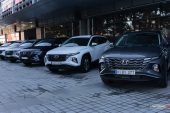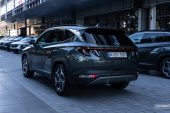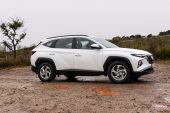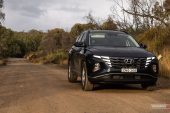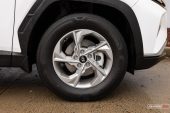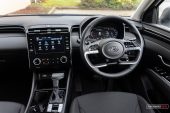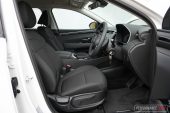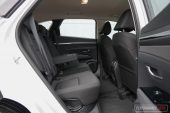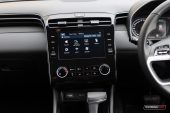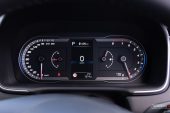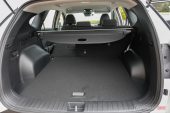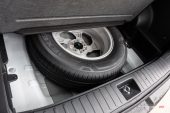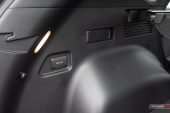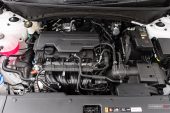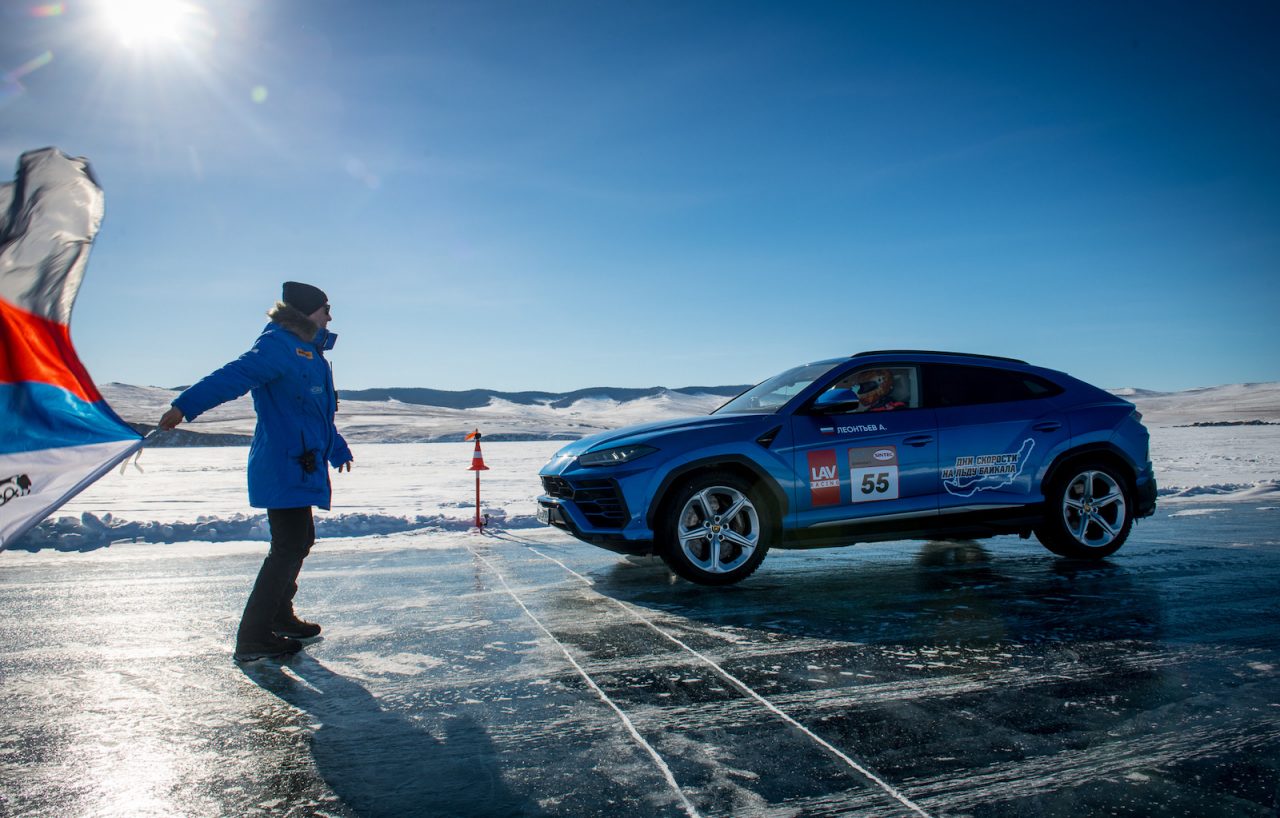That’s not a typo. It might look like something from the Euro premium brands but this is in fact the latest 2022 Hyundai Tucson. Pretty much every bit of it is new, and it’s larger, smarter, and more expensive than ever before.
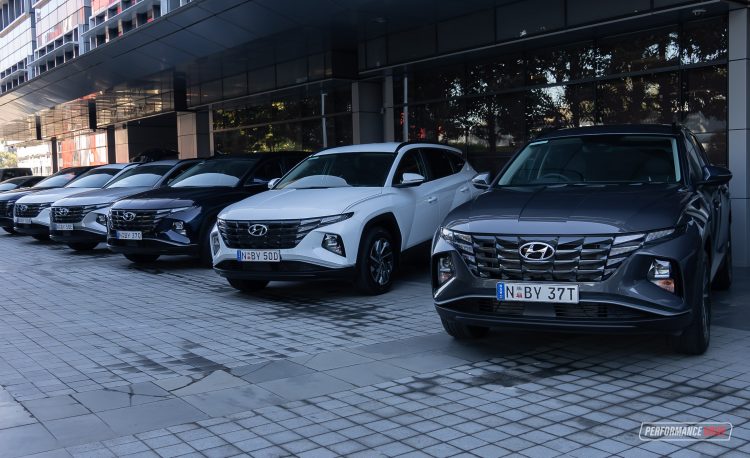
We’re here at the official Australian media launch event for a first local drive. Unfortunately, media only had a chance to sample the base-spec 2.0-litre petrol engine, but in all trim grades. A 1.6 turbo-petrol and a 2.0-litre turbo-diesel will be available later. Australia does miss out the beaut new hybrid and plug-in hybrid options offered overseas.
The local range spans from Tucson, Tucson Elite, and tops out with the Highlander. All three of these will soon be available with an optional N Line pack as well, providing varying degrees of upgrades, depending on the donor spec.
Prices start from $34,500 for the base 2.0L petrol front-wheel drive, and top out at $53,000 for the top-shelf Highlander diesel AWD. Check out the full price list in our previous story here for more. The local arm says it will be launching the 1.6 turbo in about a month, while the arrival of the turbo-diesel will coincide with the optional N Line trim pack during the third quarter.
2022 Hyundai Tucson – THE SPECS
Engine: 2.0-litre four-cylinder petrol
Output: 115kW@6200rpm / 192Nm@4500rpm
Transmission: Six-speed auto
Drive type: Front-wheel drive
Official fuel economy: 8.1L/100km
Tare weight: 1527kg
0-100km/h (tested): 11.77 seconds
Priced range: $34,500-$53,000
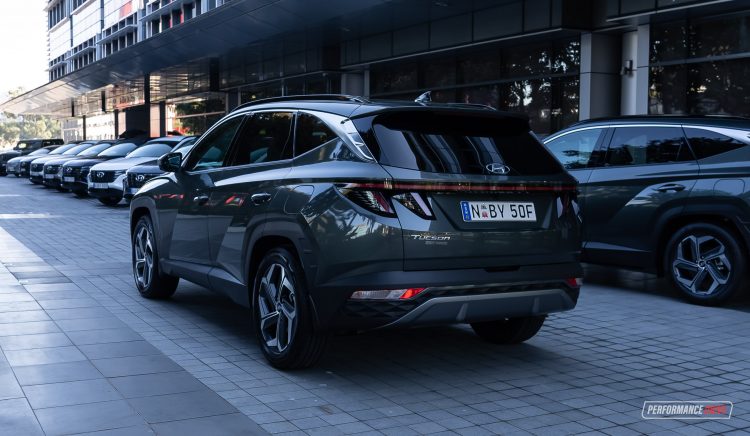
With more technology on board including in the area of safety – available segment-first blind-spot collision avoidance assist and remote smart parking – and a larger overall footprint, it’s probably a given that prices have increased. The entry model is now $2360 more expensive than the equivalent predecessor, and at the top of the field the flagship Highlander diesel is $2800 more. As such, Hyundai is trying to position the new model at the premium end. But just because the price is higher does that automatically move it into a ‘sub-premium’ class?
A number of manufacturers seem to be doing it these days. We’ve seen Mazda apply a similar philosophy and marketing spin, in particular with its latest Mazda3, and Peugeot has tried to position its latest SUV range into a higher class. At the end of the day though, like those, it can be difficult to change what something is traditionally known as. This is a Tucson, and we think it will be digested by consumers as a Tucson. At least for a reasonable ‘transition’ period. In other words, some buyers may be shooed away by these higher prices.
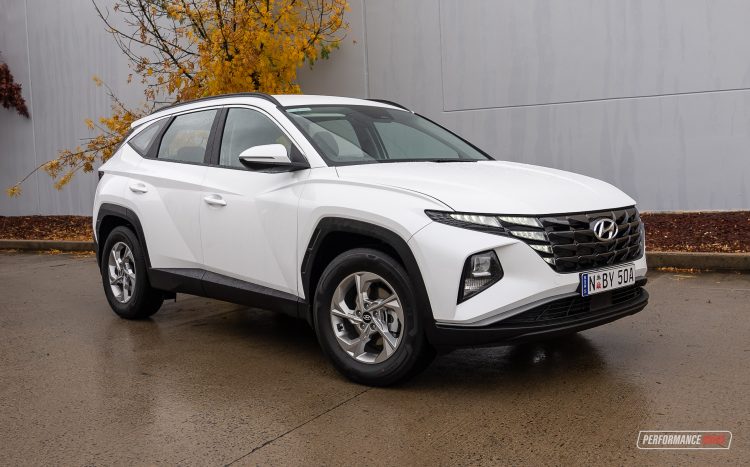
In terms of the exterior, the design team has definitely met the brief. This is a much more premium-looking vehicle than the old model. It showcases a brand new styling direction which is signified by a futuristic front grille that Hyundai calls parametric, featuring hidden headlights integrated into the outer grid – it’s very cool. The taillights are also very sophisticated and distinctive, running the fashionable full-width centre beam. Edgy body contours and carved wheel arches give it an overall strong and sturdy stance. Again, it is very distinctive and unlike anything else in this class.
Perhaps reiterating its efforts to move towards premium, Hyundai is only offering a specifically modest range of paint colours, mostly silvers and greys, dark blue, and white. There’s a dark green (Amazon Grey) available on Elite and Highlander, and Silky Bronze available exclusively on the Highlander. A rich red option, the only real ‘colour’, is reserved for the N Line pack only.
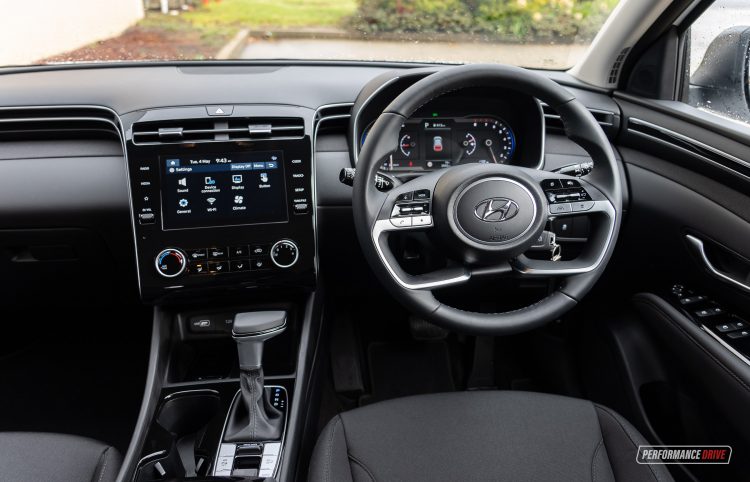
So how does the interior shape up? Like the exterior, it does look and feel more premium than ever before. Soft-touch materials are extended further throughout the cabin, including to areas that you don’t necessarily need to touch, which is great. Even the base model features a leather-wrapped steering wheel, unlike some base rivals that come with an awful plastic item. There’s a cloth strip that circles around the dash and front door trims giving it a defined theme, with seamless climate vents integrating with a trim piece that follows the enveloping cloth strip. A flush touch-screen sits on a cascading dash fascia, uniform across all trim grades, too.
The base model, which is what we drove mostly (and pictured), features an 8.0-inch screen. It is a step up from the previous base model system, and of course includes Android Auto and Apple CarPlay, a rear-view camera, but no digital radio. Moving up to the Elite and Highlander earns you a 10.25-inch screen that uses the company’s latest menu layout, and it comes with things like digital radio and satellite navigation.
Cabin space has definitely grown compared with the previous model. Aside from a more refined fit-out, it’s airy and spacious. There are many storage options around the centre console, with a rubber-lined wireless phone charging pad even on the base model, cup holders in the front, and a big centre box and arm rest. Headroom and legroom are abundant, although Hyundai says there is a reduction in front legroom… of 1mm.
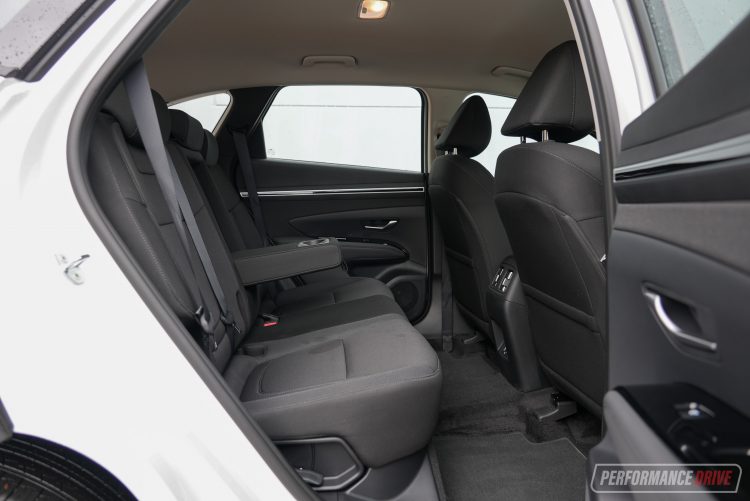
Rear legroom has increased by 80mm and headroom is up 7mm (up 14mm in the front). It’s great to see climate vents in the back, and twin USB charging ports as well as a flip-down centre arm rest with twin cup holders across all trim grades. And like the front, materials feel and look much nicer than before, especially on the Elite and Highlander.
In terms of boot space, the new model offers 539L in the default seating layout. Pull-tabs in the sidewall of the boot to fold the back seats are a handy addition, and when they are down you have an impressive 1860L at your disposal. That’s up 51L and 382L, respectively. Hyundai provides a full-size spare under the boot floor, too. There’s also a 12V socket on the side on all variants.
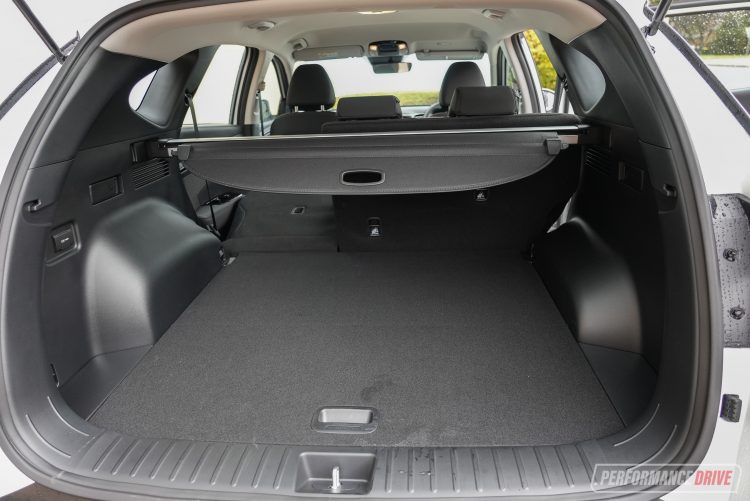
As you can probably tell, Hyundai has clearly pulled together an overall superior cabin and packaging arrangement with the new model compared with the last. Does it push the boundaries of this class, though? In terms of material quality and some design aspects, yes. Undoubtedly.
But in terms of practicality and features, aside from some segment-first safety tech, it simply marches with the leaders of the pack now rather than scurrying to catch up in the shadows. We, and you, should expect a certain level of evolution with any new model, so some things here are not surprising.
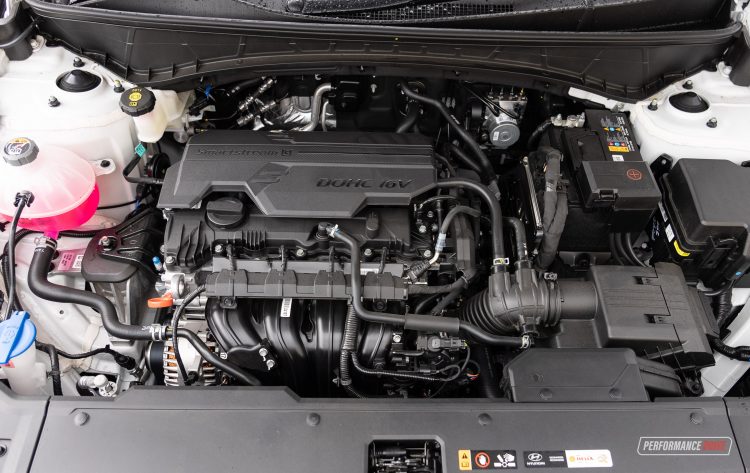
For the engine options, Hyundai Australia is offering three; a new 2.0-litre petrol four-cylinder under the Smartstream family, a 1.6-litre turbo-petrol four-cylinder Smartstream, and a 2.0-litre Smartstream turbo-diesel. Outputs range from 115kW/192Nm, 132kW/265Nm, and 137kW/416Nm. The base 2.0P features a six-speed auto with front-wheel drive. The 1.6T uses a seven-speed dual-clutch auto with all-wheel drive. And the 2.0TD uses an eight-speed auto with all-wheel drive.
These figures are less than inspiring. The base engine is actually less powerful than the one it replaces (122kW/205Nm), while the diesel gains only 1kW and 16Nm. But most disappointing of all, in our opinion, is the fact the 1.6 turbo is less powerful than the same engine that’s used in the Kona. Yep, the smaller SUV produces 148kW while the bigger and heavier Tucson makes do with 132kW. A 150kW version is also found in the i30. That, to us, is just pathetic. Come on, Hyundai. Even the new MG HS develops up to 168kW, and MG Australia has managed to secure a plug-in hybrid option with 209kW.
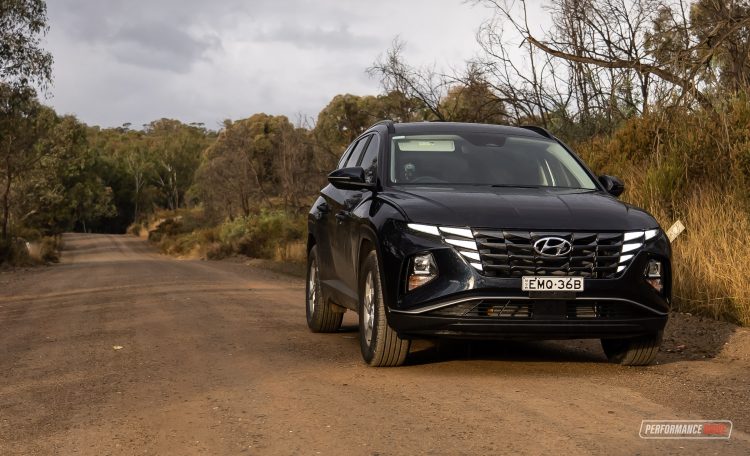
Obviously power and performance are not high priorities with the majority of mid-size SUV buyers. However, with more and more features and technologies being packed into these with every generation that passes, the kerb weight just keeps going up. So a natural evolution should include an increase in power to compensate for this. But here Hyundai has not supplied the goods. Well, in Australia anyway.
Overseas models are available with a 169kW hybrid and a 195kW plug-in hybrid. Due to production complications between left- and right-hand drive, we miss out. We can also blame the lack of firm emissions laws in Australia. So Hyundai HQ, as a result, funnels its eco-spec models to regions where there are proper fuel economy laws. However, this isn’t a challenge for Toyota Australia, MG Australia, Mitsubishi Australia, and soon Peugeot Australia – all of which offer (or will soon offer) hybrid options that are powerful and economical.
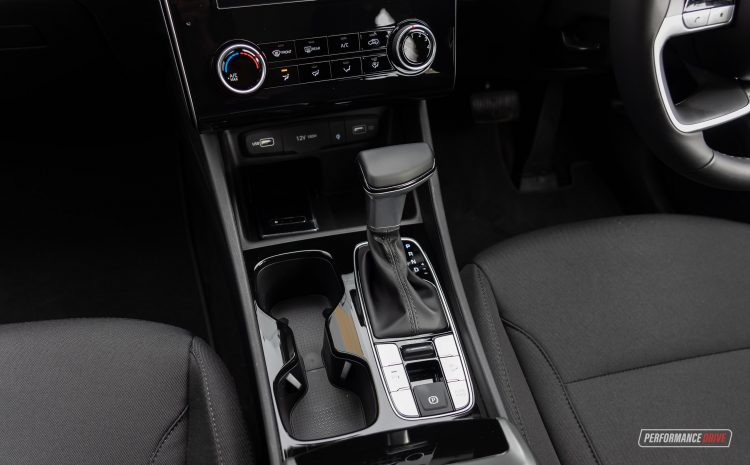
Out on the road the base 2.0 petrol is, as you’d probably guess, a yawn-inducing humdrum motor that does a lot of screaming about while achieving not much at all. A toddler, in other words. If you’re considering overtaking at anything above 80km/h, just forget it. The engine winds up and yowls, like swinging a cat by its tail, but there’s no flying release to enjoy. If you’re going up a slight hill at these speeds, it’s even worse.
The six-speed auto works hard to find the engine’s optimum rev range, shifting gears quite regularly even in normal conditions. It’s a good gearbox with a suitable spread of ratios but it’s basically saying, ‘look, this is the best that I can do with this engine’.
To remove any possibility of biased opinions, we ran some 0-100km/h tests on a quiet and flat strip of road that had a 110km/h speed limit, using our Racelogic Vbox Sport. The best we got out of the base model (which would be the lightest of the three trim lines) was 11.77 seconds. It’s very slow compared with most rivals. For reference, some times we’ve previously achieved from like-for-like rivals include: Mazda CX-5 2.0L FWD (9.28 seconds), Honda CR-V 1.5T FWD (8.34), and the outgoing Hyundai Tucson 2.0 FWD (10.72).

Again, we can’t stress enough that we aren’t expecting blistering times here. But there is a point where reasonable acceleration is needed for safe lane merging onto highways and overtaking on country roads. It’s perhaps further compounded by the fact that Hyundai does have more desirable options in its shed. There’s even the new 2.5-litre turbo-petrol found in the Sonata N Line, which develops 213kW. This engine should fit in the engine bay considering it is found in the Santa Cruz ute destined for the USA, which is based on the same platform as the new Tucson.
Let’s forget about performance as this is starting to turn into a rant. Fuel consumption. This has, unfortunately, climbed for the new model as well. This 2.0L engine is rated at 8.1L/100km while the old, more powerful unit was rated at 7.9L/100km in FWD form. However, this could be due to new testing protocols being applied since the predecessor was last officially tested. Emissions are now 184g/km and the old engine was rated at 185g/km.

Ok, enough about engines. How does it drive and ride? Well, the suspension tune is spot on in our opinion. Hyundai Australia says it tested the tune initially handed to them from overseas, but came to the conclusion that no major changes were needed. And we think that was a good decision. The body remains very flat and composed around corners, aside from some initial lean on the base model likely due to its taller tyres, and the handling response feels very positive and enjoyable.
We also like the steering feel and its precision level, although there is a minor dead zone just off centre. Again, this could be down to the tyres.
Overall, we think it is one of the better-handling propositions of this class. We like that Hyundai has left a slightly taut ride setting too, as the previous model was a bit too soft for our liking. But that’s just personal preference. Most importantly, we don’t think comfort has been sacrificed as a result.
2022 Hyundai Tucson – THE VIDEO
2022 Hyundai Tucson – THE VERDICT
We think this is a pretty average update for such a significant model line. Yes, the technology levels are stepped up, but that’s what usually happens with new models anyway, and the quality and refinement is clearly improved. We also enjoy the sharp and sophisticated design, and the well-sorted handling.
Considering it is more expensive than ever and it features underwhelming powertrain options, both in terms of performance and economy/smart technology (for the current vehicle class), we’d position its overall appeal somewhere near the current model Mazda CX-5. That’s a great vehicle – and more affordable – but one that is over four years old now.
We were hoping Hyundai would try hard to match Toyota’s commanding lead in this class, but there isn’t enough here to topple the RAV4 in our opinion. Maybe a ‘Tucson N’ will change that. Fingers crossed there’s one on the way.
